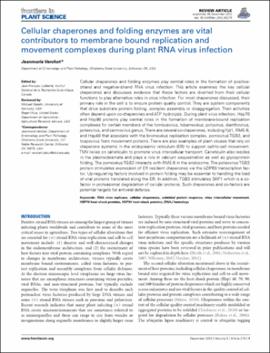| dc.contributor.author | Verchot, Jeanmarie | |
| dc.date.accessioned | 2019-08-28T16:00:54Z | |
| dc.date.available | 2019-08-28T16:00:54Z | |
| dc.date.issued | 2012-12-06 | |
| dc.identifier | oksd_verchot_cellularchapero_2012 | |
| dc.identifier.citation | Verchot, J. (2012). Cellular chaperones and folding enzymes are vital contributors to membrane bound replication and movement complexes during plant RNA virus infection. Frontiers in Plant Science, 3. https://doi.org/10.3389/fpls.2012.00275 | |
| dc.identifier.uri | https://hdl.handle.net/11244/321386 | |
| dc.description.abstract | Cellular chaperones and folding enzymes play central roles in the formation of positive-strand and negative-strand RNA virus infection. This article examines the key cellular chaperones and discusses evidence that these factors are diverted from their cellular functions to play alternative roles in virus infection. For most chaperones discussed, their primary role in the cell is to ensure protein quality control. They are system components that drive substrate protein folding, complex assembly or disaggregation. Their activities often depend upon co-chaperones and ATP hydrolysis. During plant virus infection, Hsp70 and Hsp90 proteins play central roles in the formation of membrane-bound replication complexes for certain members of the tombusvirus, tobamovirus, potyvirus, dianthovirus, potexvirus, and carmovirus genus. There are several co-chaperones, including Yjd1, RME-8, and Hsp40 that associate with the bromovirus replication complex, pomovirus TGB2, and tospovirus Nsm movement proteins. There are also examples of plant viruses that rely on chaperone systems in the endoplasmic reticulum (ER) to support cell-to-cell movement. TMV relies on calreticulin to promote virus intercellular transport. Calreticulin also resides in the plasmodesmata and plays a role in calcium sequestration as well as glycoprotein folding. The pomovirus TGB2 interacts with RME-8 in the endosome. The potexvirus TGB3 protein stimulates expression of ER resident chaperones via the bZIP60 transcription factor. Up-regulating factors involved in protein folding may be essential to handling the load of viral proteins translated along the ER. In addition, TGB3 stimulates SKP1 which is a co-factor in proteasomal degradation of cellular proteins. Such chaperones and co-factors are potential targets for antiviral defense. | |
| dc.format | application/pdf | |
| dc.language | en_US | |
| dc.publisher | Frontiers Media | |
| dc.rights | This material has been previously published. In the Oklahoma State University Library's institutional repository this version is made available through the open access principles and the terms of agreement/consent between the author(s) and the publisher. The permission policy on the use, reproduction or distribution of the material falls under fair use for educational, scholarship, and research purposes. Contact Digital Resources and Discovery Services at lib-dls@okstate.edu or 405-744-9161 for further information. | |
| dc.title | Cellular chaperones and folding enzymes are vital contributors to membrane bound replication and movement complexes during plant RNA virus infection | |
| osu.filename | oksd_verchot_cellularchapero_2012.pdf | |
| dc.description.peerreview | Peer reviewed | |
| dc.identifier.doi | 10.3389/fpls.2012.00275 | |
| dc.description.department | Entomology and Plant Pathology | |
| dc.type.genre | Article | |
| dc.type.material | Text | |
| dc.subject.keywords | rna virus replicase | |
| dc.subject.keywords | cellular chaperones | |
| dc.subject.keywords | unfolded protein response | |
| dc.subject.keywords | virus intercellular movement | |
| dc.subject.keywords | hsp70 heat-shock proteins | |
| dc.subject.keywords | hsp90 heat-shock proteins | |
| dc.subject.keywords | dnaj homologues | |
